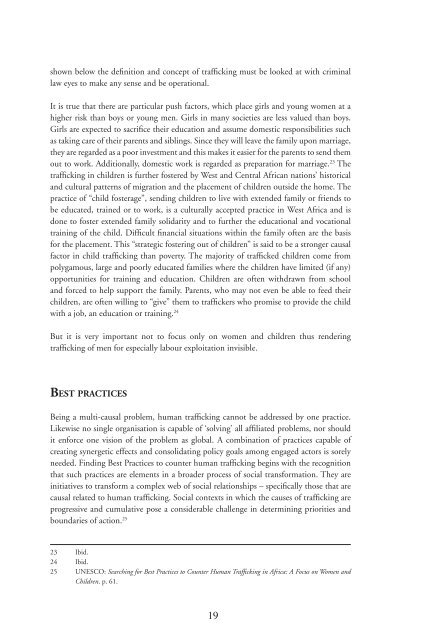Trafficking in human beings: human rights and ... - unesdoc - Unesco
Trafficking in human beings: human rights and ... - unesdoc - Unesco
Trafficking in human beings: human rights and ... - unesdoc - Unesco
Create successful ePaper yourself
Turn your PDF publications into a flip-book with our unique Google optimized e-Paper software.
shown below the defi nition <strong>and</strong> concept of traffi ck<strong>in</strong>g must be looked at with crim<strong>in</strong>al<br />
law eyes to make any sense <strong>and</strong> be operational.<br />
It is true that there are particular push factors, which place girls <strong>and</strong> young women at a<br />
higher risk than boys or young men. Girls <strong>in</strong> many societies are less valued than boys.<br />
Girls are expected to sacrifi ce their education <strong>and</strong> assume domestic responsibilities such<br />
as tak<strong>in</strong>g care of their parents <strong>and</strong> sibl<strong>in</strong>gs. S<strong>in</strong>ce they will leave the family upon marriage,<br />
they are regarded as a poor <strong>in</strong>vestment <strong>and</strong> this makes it easier for the parents to send them<br />
out to work. Additionally, domestic work is regarded as preparation for marriage. 23 The<br />
traffi ck<strong>in</strong>g <strong>in</strong> children is further fostered by West <strong>and</strong> Central African nations’ historical<br />
<strong>and</strong> cultural patterns of migration <strong>and</strong> the placement of children outside the home. The<br />
practice of “child fosterage”, send<strong>in</strong>g children to live with extended family or friends to<br />
be educated, tra<strong>in</strong>ed or to work, is a culturally accepted practice <strong>in</strong> West Africa <strong>and</strong> is<br />
done to foster extended family solidarity <strong>and</strong> to further the educational <strong>and</strong> vocational<br />
tra<strong>in</strong><strong>in</strong>g of the child. Diffi cult fi nancial situations with<strong>in</strong> the family often are the basis<br />
for the placement. This “strategic foster<strong>in</strong>g out of children” is said to be a stronger causal<br />
factor <strong>in</strong> child traffi ck<strong>in</strong>g than poverty. The majority of traffi cked children come from<br />
polygamous, large <strong>and</strong> poorly educated families where the children have limited (if any)<br />
opportunities for tra<strong>in</strong><strong>in</strong>g <strong>and</strong> education. Children are often withdrawn from school<br />
<strong>and</strong> forced to help support the family. Parents, who may not even be able to feed their<br />
children, are often will<strong>in</strong>g to “give” them to traffi ckers who promise to provide the child<br />
with a job, an education or tra<strong>in</strong><strong>in</strong>g. 24<br />
But it is very important not to focus only on women <strong>and</strong> children thus render<strong>in</strong>g<br />
traffi ck<strong>in</strong>g of men for especially labour exploitation <strong>in</strong>visible.<br />
BEST PRACTICES<br />
Be<strong>in</strong>g a multi-causal problem, <strong>human</strong> traffi ck<strong>in</strong>g cannot be addressed by one practice.<br />
Likewise no s<strong>in</strong>gle organisation is capable of ‘solv<strong>in</strong>g’ all affi liated problems, nor should<br />
it enforce one vision of the problem as global. A comb<strong>in</strong>ation of practices capable of<br />
creat<strong>in</strong>g synergetic effects <strong>and</strong> consolidat<strong>in</strong>g policy goals among engaged actors is sorely<br />
needed. F<strong>in</strong>d<strong>in</strong>g Best Practices to counter <strong>human</strong> traffi ck<strong>in</strong>g beg<strong>in</strong>s with the recognition<br />
that such practices are elements <strong>in</strong> a broader process of social transformation. They are<br />
<strong>in</strong>itiatives to transform a complex web of social relationships – specifi cally those that are<br />
causal related to <strong>human</strong> traffi ck<strong>in</strong>g. Social contexts <strong>in</strong> which the causes of traffi ck<strong>in</strong>g are<br />
progressive <strong>and</strong> cumulative pose a considerable challenge <strong>in</strong> determ<strong>in</strong><strong>in</strong>g priorities <strong>and</strong><br />
boundaries of action. 25<br />
23 Ibid.<br />
24 Ibid.<br />
25 UNESCO: Search<strong>in</strong>g for Best Practices to Counter Human Traffi ck<strong>in</strong>g <strong>in</strong> Africa: A Focus on Women <strong>and</strong><br />
Children. p. 61.<br />
19

















